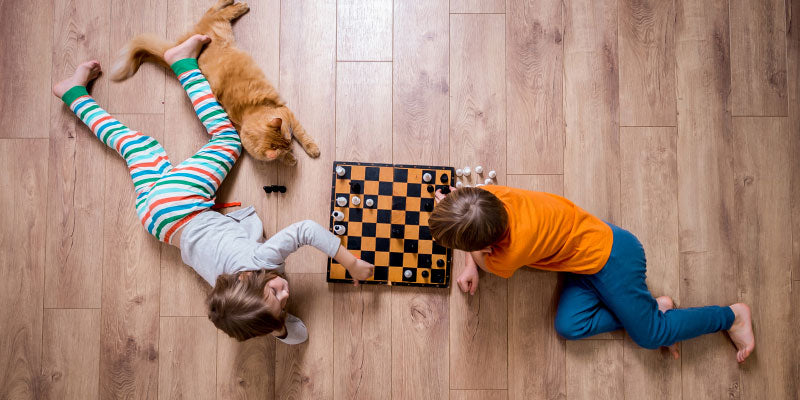
What is the Best Type of Flooring for Kids?
|
|
Time to read 5 min
|
|
Time to read 5 min
Whether you live with babies just learning to crawl, toddlers throwing their toys, or young kids running in muddy shoes, your floors will need to put up with a lot of punishment. If these scenes are all too familiar, or if you foresee them in the future, you may want to look into the best types of flooring for kids. You’ll want floors that not only are safe for your kids but also can stand up to their spills and boisterous play. If you’re looking for the best flooring solutions for a home with kids, keep reading for more information about the best options.
One of the biggest advantages that hardwood flooring has over carpeting is that it’s easier to clean. Hardwood can also withstand years of abuse from young children and simply requires sanding to repair any marks or scratches. Additionally, hardwood doesn’t collect animal dander, mold, pollen, or dust like carpet does, so it’s good for children who suffer from allergies. When you’re looking for the ideal type of wood for your home, there are many to consider.
Oak is one of the most popular choices for hardwood flooring, and the most common varieties are red oak and white oak. While both are hard and durable, red oak has a stronger grain, so it hides dents and scratches better than white oak does.
Australian cypress is even harder than oak. It has a wavy grain and tends to have knots. While the wood can sometimes chip or split around these knots, the lively grain can help hide nicks and scratches your child might accidentally make. Another wood harder than oak is Brazilian cherry. This wood also withstands moisture very well, so it’s good in kitchens where sippy cups might tip over.
When you’re picking out hardwood flooring, keep in mind that lighter colors can help hide dents and scratches better than darker colors. You can also pick out distressed flooring that has stylized or natural lines and imperfections that can help hide any dents or scratches your children might make. Finally, immediately wipe up any spills so your hardwood doesn’t warp or stain. For a more waterproof option, look into engineered hardwood flooring, which has been enhanced to make it impervious to liquids.
For those who like the look of hardwood but don’t have the budget for it, laminate floors are a good wood like flooring option that works well for people with young children. Laminate floors are compressed pieces of veneer that have the image of a wood species pressed on top. Along with being less expensive than hardwood, laminate also doesn’t require waxing or polishing to keep it looking nice. A vacuum cleaner, broom, and damp mop are all you need to keep laminate floors clean.
One type of flooring that’s kid-friendly, and growing in popularity, is bamboo . While technically a grass and not a wood, bamboo is often grouped with other species as hardwood flooring. One reason for this is that bamboo is one of the most durable and hardest floor choices available. It’s also stain-resistant, so it’s a good choice in areas where children might have accidental spills. Plus, since it grows so quickly and is easy to re-establish, it’s a very environmentally friendly product. Like other flooring options, there are differences in the types of bamboo floors available. Strand-woven bamboo plank flooring is the strongest variety, while caramelized bamboo is weaker. Like carpet, cork is naturally soft beneath your feet even though it has the look of hardwood. One of the main advantages that cork has over carpet is that it’s antimicrobial. It also naturally repels mold growth. When cork is sealed properly, it’s nearly impossible to stain. Cork is antistatic, so dirt and dust won’t stick to it like they do carpet. This makes cork very easy to clean and helps kids who suffer from allergies enjoy a cleaner room. To keep cork clean, you simply need to vacuum or sweep periodically. Soft cork floors are easily replaceable if damaged. While cork flooring has the look of hardwood, it’s very soft, so it’s easy to damage or scratch. The hard edges of toys can cause gouges, tears, and rips in the material. However, if you use cork tiles for your flooring, you can simply replace individual pieces as they become damaged. Step into nearly any daycare and chances are good you’ll see rubber flooring. Rubber is very strong and can stand up to a variety of conditions. When properly cared for, rubber flooring can last 20 years or longer. It’s also very easy to take care of and clean. Typically, you just need warm, clean water and a mop to keep a rubber floor clean. Synthetic rubber flooring is usually more stain-resistant than natural rubber flooring. Plus, thick tiles can reduce noise by up to 18 decibels, and they provide extra cushioning for accidental falls. Rubber can have a noticeable odor. Since rubber is a natural material, the odor isn’t harmful. However, some children find it irritating. If you’re considering rubber for a bedroom or playroom, you may want to test how your children react to the odor before you make your purchase. If you have carpet or hardwood already installed and you’re considering a temporary floor covering to help protect them while your children are young, consider carpet or rubber flooring for kids. This idea is one of the best flooring solutions for kids because it provides a soft place for children to play while protecting the floor underneath. Floor mats for kids’ rooms are also easy to clean, and if one happens to get damaged, you can simply swap it out for a new one.Bamboo Flooring
Cork Flooring
Rubber Flooring
Kids’ Floor Mats